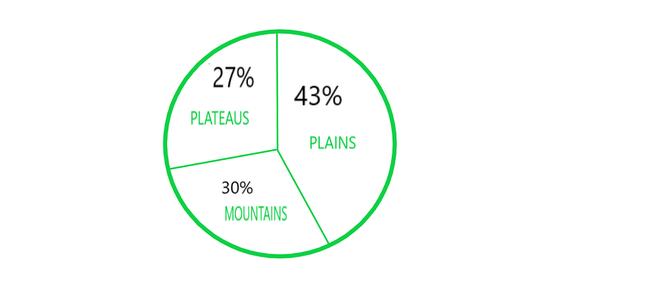土壤的形成和分类
在我们的环境中,有很多材料可以用来满足我们的一般需求,经济上可行,文化上可以接受,更多的是在技术上可以使用,被称为“资源”。生物本身就是资源的主要组成部分之一。他们是唯一将环境中可用的材料转化为资源并使用它们的人。
在本文中,我们将讨论印度的土地资源及其格局、作为土地资源的土壤及其侵蚀和保护。
什么是土地资源?
土地是整个人类赖以生存的资源。它支持经济活动、自然植被、野生动物、人类生活、交通和通讯系统,支持我们所需的所有必要活动。在印度,土地分为不同的部分;高原、山脉、岛屿和平原如饼图所示:

重要救济特征下的土地
它们主要有两种类型:
- 非农业用地和
- 贫瘠荒地
休耕地:用于耕作目的的土地,但为了使其恢复肥力,这些土地在一个季节内没有庄稼。
其他未耕地(不包括休耕地)。
土壤作为资源
土壤是最重要的天然可再生资源之一。它提供了人类可以维持的环境,植物可以生长并支持地球上不同类型的生物体。
- 自然过程需要数千年的时间才能形成几厘米深的土壤。温度变化、流水冲过岩石、分解者的活动等自然现象会导致土壤的形成。
- 母岩或河谷岩、气候变化以及其他生命形式和时间是形成土壤的重要因素。
- 土壤还含有一些无机和有机(腐殖质)化合物。
Classification of Soils
On the basis of the factors responsible for soil formation, colour, thickness, texture, age, chemical and physical properties, The soil is classified as:-
- Alluvial Soil
- Black Cotton Soil
- Red & Yellow Soil
- Laterite Soil
- Mountainous or Forest Soil
- Arid or Desert Soil
- Saline and Alkaline Soil.
冲积土
The major part of India under Alluvial soil is Northern India and its river valley – the Ganga, the Indus and the Brahmaputra.
The composition of alluvial soil is as: sand, silt and clay. Soil particles appear to be bigger in size as we move inner toward river valleys whereas the soils are coarse, in the upper side of the river valley. They are rich in potassium but lack phosphorus present.
根据年龄,冲积土分为两类:
- Bhangar(旧冲积层):这种土壤含有比 Khadar 更高浓度的 Kankar 或石头。
- Khadar(新冲积层):这种含有细颗粒,因此它比Bhangar更肥沃。
这些土壤含有足够比例的矿物质,如磷、钾肥和石灰等,这些矿物质是甘蔗、稻谷、小麦和其他谷类和豆类作物生长所需的。
黑土
It covers most of the Deccan Plateau – Madhya Pradesh, Gujarat, Andhra Pradesh, parts of Maharashtra, and some parts of Tamil Nadu. This soil is ideal for the growth of cotton that’s why this soil is also called Black cotton soil.
黑色由极细的粘土颗粒组成,具有很好的保湿性。黑土富含适合植物生长的养分,还含有碳酸钙、镁、钾和石灰。
黑土栽培植物主要有棉花、豆类、小米、蓖麻、甘蔗、柑橘类水果、亚麻籽等。
红土和黄土
This type of soil develops in areas of low rainfall on the crystalline igneous rocks in the southern and eastern parts of the Deccan plateau.
由于铁在结晶岩和变质岩中的扩散,这种土壤呈淡红色。当它水合不足时,颜色呈黄色。
印度的该地区位于恰蒂斯加尔邦、奥里萨邦的部分地区、恒河中部平原的南部和西高止山脉的部分地区。
红土土
The part of India under laterite soil is, in the Western Ghats region of Maharashtra, Odisha, Southern states, some parts of West Bengal and north-eastern states also. The laterite soils are generally acidic in nature having ph less than 6.0 which does have enough nutrients for plants.
在干湿交替的热带和亚热带气候下,红土土壤发育。土壤支持常绿和落叶林,但腐殖质浓度很低。对于茶和咖啡种植园来说,这种土壤是有利的。
干旱土壤
The colour of Arid soil is Reddish brown. This soil is generally saline in nature and sandy in texture. This kind of soil has lack humus and moisture content.
由于向下增加的钙含量,土壤的较低层被Kankar占据。底部视野中的 Kankar 层形成导致水的过滤。
森林土壤
It is found in the northern region of India such as Punjab, Uttar Pradesh, Bihar, West Bengal, Assam. The soil texture is coarse-grained in the upper slopes and loamy and silty in valley sides. The soil is fertile in the river valleys.
示例问题
问题一:按年代划分 冲积土有多少种并命名。
回答:
There are two types of Alluvial soil on the basis of Age are as:
- Bhangar soil
- Khadar soil
问题2:哪种土壤叫做棉花土,这种土壤是在印度哪个地区发现的。
回答:
Black soil is Ideal for the growth of the cotton that’s why this soil is also called Black cotton soil. The black soil covers most of the Deccan Plateau – Madhya Pradesh, Gujarat, Andhra Pradesh, parts of Maharashtra, and some parts of Tamil Nadu.
问题 3:描述冲积土的一些性质。
回答:
Some of the Major properties of Alluvial soil are as:
- The major part in India under Alluvial soil is Northern India and its river valley – the Ganga, the Indus and the Brahmaputra..
- The composition of alluvial soil is as: sand, silt and clay. Soil particles appear to be bigger in size as we move inner toward river valleys whereas the soils are coarse, in the upper side of the river valley.
- They are rich in potassium but lack of phosphorus present.
- These soils contain an adequate proportion of minerals such as Phosphorus, potash and lime etc.. needs for the growth of sugarcane, paddy, wheat and other cereal and pulse crops.
问题4:描述红土和黄土的性质。
回答:
The basic properties of red and yellow soil are as:-
- Due to diffusion of iron in crystalline and metamorphic rocks this soil develops a reddish color . When it is under hydrated form the color appears as yellow.
- The region in India it is found in parts of Chhattisgarh, Odisha, southern parts of the middle Ganga plain and some part of western ghats.
问题5:在印度哪个地区发现了红土。
回答:
The laterite soil found in Western Ghats region of Maharashtra, Odisha, Southern states, some parts of West Bengal and north-eastern states also.